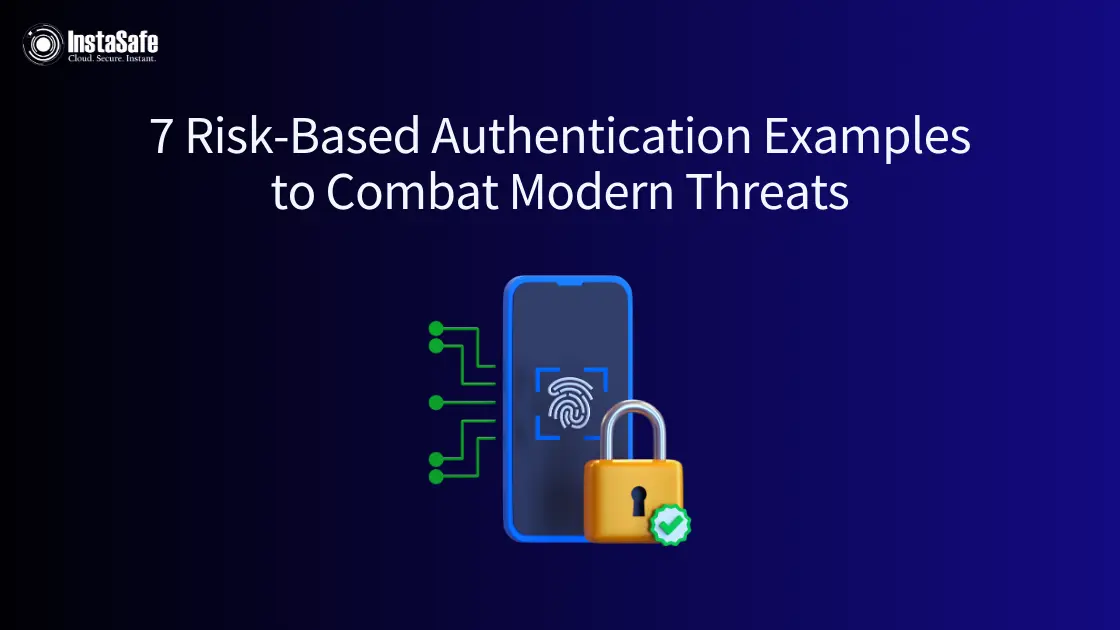7 Risk-Based Authentication Examples to Combat Modern Threats

Cyber attackers are getting smarter. Passwords alone can not protect your data anymore. Risk-based authentication analyses each login attempt in real-time, identifying suspicious activity instantly. This smart security approach adds extra verification only when needed, balancing strong protection with user convenience.
What Is Risk-Based Authentication?
Risk-based authentication (RBA) analyses each login attempt in real time to determine its risk level. Unlike traditional password systems, adaptive authentication changes the level of protection needed for each login based on the circumstances.
When something seems suspicious—like logging in from an unfamiliar location—the system requires additional verification steps.
Risk-based authentication, also called adaptive authentication or risk-based MFA, uses machine learning to assign a risk level to every authentication request. Depending on the perceived risk, it decides whether to prompt for additional authentication factors or allow access with just basic credentials.
How Risk-Based Authentication Works?
Risk-based authentication solutions assess multiple factors during login attempts, including:
- Device information and fingerprinting
- Geographic location and distance from typical access points
- IP address reputation and history
- Time of login compared to normal patterns
- Network information and security level
- User behaviour patterns and typing characteristics
- Sensitivity of requested resources
The system calculates a score based on these factors in real time. A higher risk score implies a deviation from usual behaviour—such as requests from dubious IP addresses, login attempts from new devices, unfamiliar locations or unusual times.
Since RBA uses machine learning to process risks, it becomes more intelligent over time, learning from user behaviour and security events to assess risks more accurately in different situations.
7 Practical Applications of Risk-Based Authentication
1. Detecting Credential Theft
Risk-based authentication example: An employee in Chicago logs into their account during work hours. Simultaneously, someone tries to access the same account from overseas using stolen credentials.
RBA in Action: The system detects the geographical inconsistency, assigns a high-risk score and requires additional verification. The legitimate employee can provide it, while the attacker cannot, preventing unauthorised access.
Even if access attempts occur hours apart, the system recognises the impossibility of international travel in a short timeframe and blocks suspicious logins.
2. Protecting Against Insecure WiFi Hotspots
Risk-based authentication example: An employee connects to your corporate network through public WiFi, where attackers might execute man-in-the-middle attacks to capture credentials.
RBA in Action: The system recognises the unfamiliar network and calculates a risk score based on the network's reputation and security level. If deemed risky, it triggers multi-factor authentication, blocking potential intruders.
Static MFA rules might automatically trust connections from certain geographic regions, but risk-based authentication examines the specific network characteristics to identify potential threats.
3. Preventing Phishing and Malware Attacks
Risk-based authentication example: Malware infects an employee's device through a phishing email and attempts to access your company network and sensitive applications.
RBA in Action: Adaptive authentication identifies the unusual device fingerprint (the malware's HTTP client) and requires additional verification. Since the malware cannot complete human-based authentication factors like biometrics or one-time passwords, the attack fails.
This prevents the malware from using brute force to access sensitive data, even when operating from trusted company networks where static MFA rules might not flag suspicious activity.
4. Stopping Credential Stuffing
Risk-based authentication example: A hacker uses credentials from a data breach to bombard your login system, hoping some will work. If an employee uses the same credentials across multiple sites, including those in the leaked data, traditional security might be compromised.
RBA in Action: The system analyses login patterns in real time, considering factors like login time, the device used and login history. Even from trusted IP addresses, the risk-based authentication solution increases the risk score when it detects multiple rapid login attempts or other anomalous patterns.
This stops automated scripts from successfully executing credential stuffing attacks, protecting your valuable data even when legitimate credentials are used.
5. Optimising Security for Remote Workers
Risk-based authentication example: An employee works from home, logging in from the same location and device daily for weeks.
RBA in Action: The system learns this pattern over time and assigns lower risk scores to these consistent logins. This allows the employee to access resources with minimal friction, improving productivity and user satisfaction.
Static MFA rules would force verification for every login attempt, creating unnecessary burdens and potential alert fatigue in security monitoring systems. Adaptive risk-based authentication intelligently reduces friction for legitimate, expected access patterns.
6. Mitigating App Vulnerabilities
Risk-based authentication example: A cybercriminal exploits a vulnerability in your application due to a misconfiguration, potentially bypassing the authentication process or generating inaccurate event logs.
RBA in Action: Adaptive risk-based authentication analyses risk factors beyond just the logs to determine threat likelihood accurately. Its context-based authentication mechanism identifies app misconfiguration and resulting irregularities, triggering additional verification requirements.
7. Blocking Anonymous Access Attempts
Risk-based authentication example: An attacker uses Tor to mask their location while attempting to access your network using stolen credentials during office hours, mimicking the browser and OS used by your employee.
RBA in Action: The system detects the unfamiliar IP address, anonymity network usage and other contextual anomalies, assigning a high-risk score even though some factors (time of day, browser fingerprint) appear legitimate.
This prompts additional verification requirements that the attacker cannot satisfy, preventing unauthorised access to network resources and protecting sensitive data.
Benefits of Risk-Based Authentication
Adaptive risk-based authentication offers several advantages over traditional methods:
- Enhanced Security: Reduces reliance on easily compromised passwords and provides contextual protection
- Improved User Experience: Low-risk users enjoy friction-free logins while additional verification is reserved for suspicious activities
- Fraud Prevention: Quickly identifies suspicious patterns and blocks potential attacks before they succeed
- Adaptability: Becomes more intelligent over time through machine learning and continuous improvement
- Compliance: Helps fulfil data protection and access management regulations
- Resource Optimisation: Reduces false positives by focusing security measures where they are most needed
Conclusion
Traditional authentication methods like passwords or static multi-factor authentication rules are increasingly inadequate against sophisticated cyber threats. Risk-based authentication solutions provide the adaptive security needed to protect digital assets while maintaining a positive user experience.
Instasafe's multi-factor authentication offers powerful protection against modern cyber threats. When something seems risky, Instasafe requires extra verification steps to keep your data secure while maintaining convenience. This smart security approach adapts to each situation, providing the perfect balance of protection and usability.
Frequently Asked Questions (FAQs)
- What are the types of authentication methods implemented by security administrators?
Password-based, token-based, biometric, certificate-based and multi-factor authentication are common methods implemented by security administrators. Each provides different security levels and user experiences.
- What is the best authentication method?
Multi-factor authentication (MFA) is generally considered best as it combines multiple verification layers, significantly reducing compromise risks while maintaining reasonable usability.
- What are risk-based authentication models?
Risk-based authentication models dynamically adjust security requirements based on contextual factors like user behaviour, location, device and access patterns to determine appropriate authentication strength.
- What is risk-based authentication?
Risk-based authentication evaluates contextual factors to determine security levels. It analyses login behaviour, location, device and network to apply appropriate authentication requirements based on perceived risk.
